|
|
Created/dedicated as per personal communication with Yolanda Acevedo, August, 2006
Updated as per personal communication with Marc and Kurtis Cook, December 2008
Updated as per James P. Tuttle's The Hawk Moths of North America, July 2010
Updated as per personal communication with Yolanda Acevedo, July 2010
Updated as per personal communication with Lisa Mullen (Eumorpha fasciatus, Apollo, September 20, 2012); September 20, 2012
|
Hillsborough County, Florida
Sphingidae
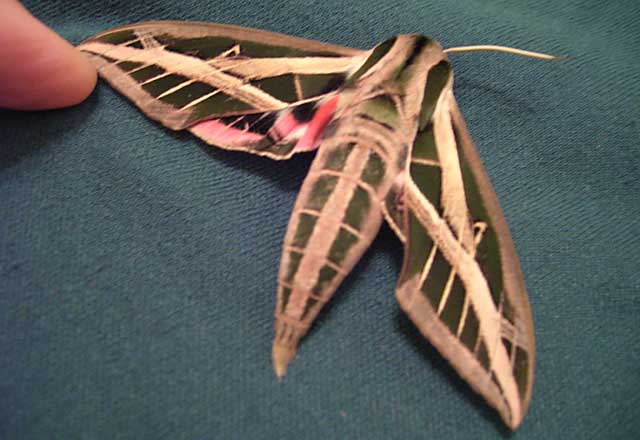
Eumorpha fasciatus, Brandon, Florida, August 29, 2006,
courtesy of Yolanda Acevedo.
This page is inspired by and dedicated to
Yolanda Acevedo who sent me the image of Eumorpha fasciatus
at the top of this page. Yolanda has also sent what I was pretty sure
is a Darapsa myron mexicana from Tampa, Florida, at the bottom
of the page. However, Jean Haxaire indicates "it is not mexicana, but
a pale form of myron."
Yolanda writes, "Don't know if you're still collecting data for
your site (REALLY nice, by-the-way). I live in Brandon, FL -
just east of Tampa in Hillsborough County. My daughters have come
accross a Eumorpha fasciatus fasciatus in our front entryway
yesterday morning. I believe now they understand that they should
keep the screen door closed after they come into the entryway."
In January 2008, Yolanda send me an image of a Xylophanes tersa
moth, sighted by her daughter at a school in Plant City.
Special thanks also goes to Marc and Kurtis Cook who sent me images of
Eumorpha labruscae, December 29, 2007, from Plant City.
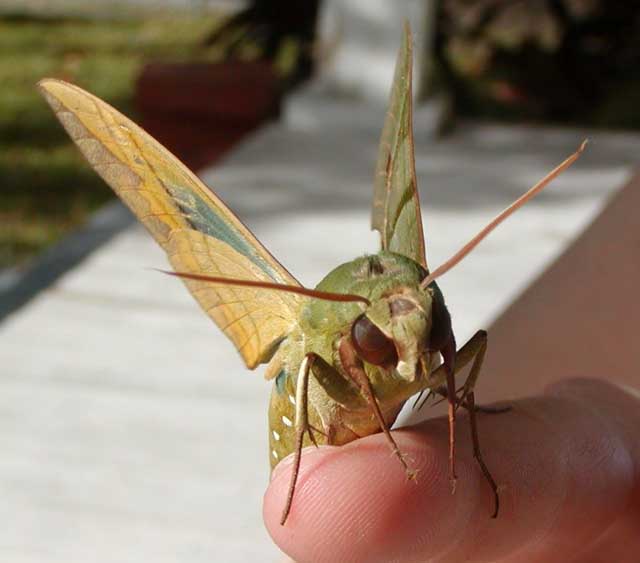
Eumorpha labruscae, December 29, 2007, Plant City, Hillsborough County,
Florida,
courtesy of Marc and Kurtis Cook.
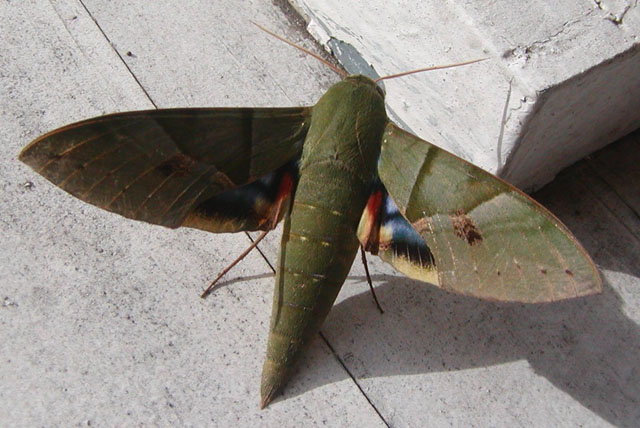
Eumorpha labruscae, December 29, 2007, Plant City, Hillsborough County,
Florida,
courtesy of Marc and Kurtis Cook.
Marc writes, "The picture was taken at about 11 am in the morning
December 29th 2007. We live in the extreme northeast corner of
Hillsborough County, Florida. The moth was on our front porch. I
gently handed it to my son Kurtis, and he held it for the picture.
Just before it took off from his hand, it excreted some sort of clear
liquid. It flew away very very fast. We are pleased to share this
moth, and look forward to seeing the post on your web site."
Sixty-five Sphingidae species are listed for Florida on the U.S.G.S.
website. Not all of the species are reported or anticipated in
Hillsborough County (Fifteen species are reported on U.S.G.S.). It is hoped
that this checklist, with the thumbnails and notes, will help you
quickly identify the moths you are likely to encounter.
A "WO" after the species name indicates that
I have no confirmed reports of this species in Hillsborough County, but I
(William Oehlke) expect that this moth is present or
might be present.
A "USGS"
indicates the moth is reported on the USGS website and/or in
Lepidoptera of North America, #1. Distribution of Silkmoths (Saturniidae) and Hawkmoths (Sphingidae)
of Eastern North America,
an excellent little booklet available through Paul Opler.
Please help me develop this list with improved, documented accuracy
by sending sightings (species, date, location), preferably with an
electronic image, via email to Bill Oehlke.
The night-blooming moon flower will attract many Sphingidae at dusk and into the night.
Many thanks to Lisa Mullen and her daughter who povide the following image of Eumorpha fasciatus the Banded Sphinx.
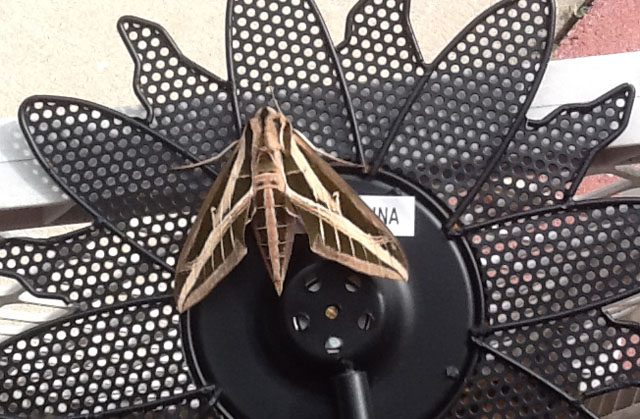
Emorpha fasciatus, Apollo Beach, Hillsborough County, Florida,
September 20, 2012, courtesy of Lisa Mullen and daughter.
Lis Mullen writes, "Hello! My daughter and I came across this moth at 10:30 a.m. today while checking our outdoor thermometer. It is on the back of the
thermometer; it is a stick in the ground thermometer shaped like a flower. In the picture I have it out of the ground propped on a gate so we could see the
moth well. We live in Apollo Beach, in Hillsborough County, Florida.
"We would love to know what it is. From your site it seems it may be a Banded Sphinx or a Vine Sphinx. We cannot agree! :). Hopefully you will be able to tell us
what moth this is."
Thanks for thinking of me and sending the beautiful image of Eumorpha fasciatus, the Banded Sphinx. It is very similar to Eumorpha vitis
the Vine Sphinx, but the Vine Sphinx always has the lower of the three subparallel thin white lines cutting through the much thicker off-white line so that there
is a substantial brown trapezoid shape bordered by the two thick off-white lines and the lowest two thin white line. It is hard to describe, and usually goes unnoticed
unless you know to look for that feature. I hope I have described it well enough for you to see it.
In the Vine.
In the Banded Sphinx, your sphinx, there is only a slight separation between the two thicker off-white lines,
and the two lower thin white line only help to outline a very thin wedge.
I have placed a red rectangle around the thin brown wedge I refer to in fasciatus as bounded by two thin white lines and two much thicker off-white lines.
If you visit the thumbnail of the Vine Sphinx much further below, you wil see a much more substantial brown area bounded by those same lines."
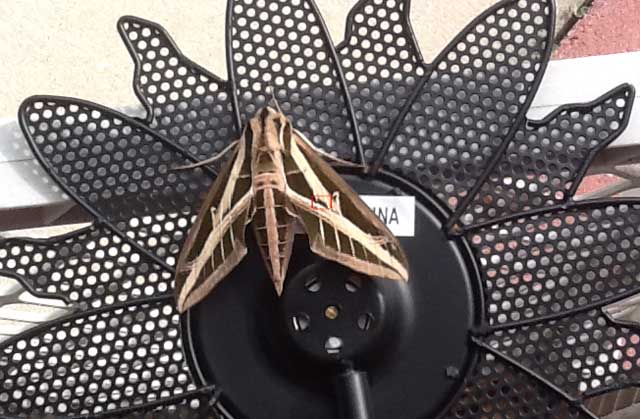
Emorpha fasciatus, Apollo Beach, Hillsborough County, Florida,
September 20, 2012, courtesy of Lisa Mullen and daughter.
Visit Hillsborough County Sphingidae larvae (CATERPILLARS).
Visit Florida Catocala (UNDERWING MOTHS).
Sphinginae subfamily
Sphingini tribe:
 |
Agrius cingulata,
WO/YA Pink-spotted hawkmoth,
stray.
This species is a strong migrant and adults nectar from
deep-throated flowers including moonflower (Calonyction aculeatum),
morning glory (Convolvulus), honey suckle (Lonicera)
and petunia (Petunia species).
|
Agrius cingulata, July 18, 2008, Brandon, Hillsborough Co., Florida, courtesy of
Yolanda Acevedo
 |
Ceratomia amyntor
WO, unlikely, generally more northerly,
the Elm Sphinx or Four-horned Sphinx
The upperside of the forewing is brown with dark brown and white markings including a white costal area near the wing base, dark streaks along the veins,
and a white spot in the cell.
Larvae feed on Elm (Ulmus), birch (Betula), basswood (Tilia), and
cherry (Prunus). unlikely |
 |
The upperside of the forewing is yellowish brown with no white markings, but there are indistinct black lines and dashes. The cell spot is gray with a black outline. The larvae feed in large groups and are much more
spectacular than the moths.
Catalpa is the larval host. |
 |
The upperside of the forewing is pale brownish gray with wavy black and white lines and a black-outlined white cell spot.
The upperside of the hindwing is gray with diffuse darker bands. |
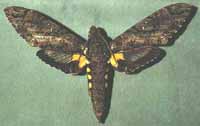
|
The upperside of the forewing is a blurry yellowish gray. The
upperside of the hindwing is dark gray with yellow at the base and a
dark "tooth" projecting from the margin into the translucent area
between each vein.
|
 |
The upperside of the forewing is dark brown with a dusting of white
scales. Some moths have patches of reddish or yellowish brown on the
wings.
|
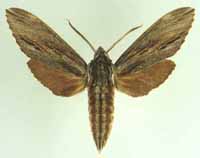 |
Isoparce cupressi
WO, the Cypress or Baldcypress Sphinx
Isoparce cupressi, the rare Cypress Sphinx, flies in Cypress swamps in Georgia (specimen type locality), and from Maryland to Texas.
It has been reported in Mexico.
|
 |
The upperside is of the forewing is gray with two
(sometimes one or three) black dashes near the wing center; other
markings are usually diffuse. The upperside of the hindwing is a uniform brown-gray.
If you've got pines, this species is likely present. |
 |
If you grow tomatoes, you might encounter Manduca quinquemaculata.
|
 |
Look for three large yellow spots
on each side of the abdomen. The upperside of the forewing is
yellowish brown to deep chocolate brown with a dusting of white
scales and zigzagged black and white lines.
|
 |
If you grow tomatoes, you have probably encountered Manduca sexta
in the larval stage.
Larvae get very large and can strip a tomato plant.
|
 | The upperside of the forewing is gray with indistinct black and
white markings. There is a series of black dashes
from the base to the tip, and a small white cell spot.
|
 |
Sphinx chersis
USGS, the Northern Ash Sphinx or Great Ash
Sphinx
The upperside of the forewing is soft dark gray to blue-gray with
a series of black dashes, one of which reaches the wing tip.
|
 |
The upperside of the forewing ranges from brown with black borders
through brownish gray with paler borders to pale gray with no
borders. |
Smerinthini Tribe:
 |
The adults are also highly variable; sometimes wings of an individual
may be all one color or may have several colors, ranging from pale to
dark brown, and may have a white or pink tinge. Patterns range from
faint to pronounced.
See the file for the female; she is different. |
 |
Pachysphinx modesta
WO, generally more northerly,
the Modest Sphinx or Poplar Sphinx
They are common on Prince Edward Island, and are
remote possibility for Hillsborough County. |
 |
Named for the dull grey-blue spot (minus dark pupil) in the hindwing,
this moth has a wide distribution in the eastern United States.
I regularly see them on Prince Edward Island, and they are reported
as far south as southern Florida. |
 |
Named for the small eye-spot in the hindwing, this moth has a wide
distribution and is probably present in Seminole County.
I regularly see them on Prince Edward Island, and they are reported
as far south as southern Florida.
|
 |
Smerinthus jamaicensis
WO, generally more northerly,
the Twin-spotted Sphinx
This moth is widely distributed and fairly common.
Along the East Coast, it flies from P.E.I. to Florida.
slight possibility |
Macroglossinae subfamily
Dilophonotini tribe:
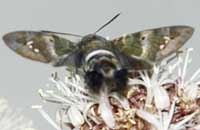 |
Aellopos tantalus
USGS, stray from further south, the Tantalus Sphinx
The body is reddish brown with a wide white band across the abdomen.
The forewing upperside is reddish brown with a black cell spot and 3
white spots near the gray marginal area. A pale streak runs from
the cell spot to the inner margin of the wing.
|
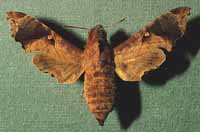
|
Enyo lugubris, the Mournful Sphinx,
USGS
The body and wings are dark brown. The forewing has a large black
patch covering most of the outer half of the wing. There is a pale
tan cell spot (dark inner pupil), and a fairly straight median line
to the inside of the cell spot.
|
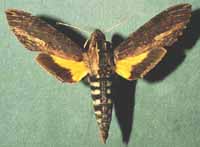 |
The upperside of the forewing is dark brown with short yellowish
streaks on the forward half and wavy yellowish bands on the rear
half.
|
 |
The abdomen has very distinct gray and black bands. The female's
forewing upperside is pale gray with a few dark dots near the outer
margin.
|
 |
During the night adults nectar at flowers, including bouncing bet
(Saponaria officinalis) and Asystasia gangetica beginning at dusk.
July and August are flight times in the southern states.
possibility
|
See Hemaris comparison to help distinguish
the next two species.
 |
Hemaris thysbe
USGS, the Hummingbird Clearwing
It is not difficult to see why many gardeners would mistake an
Hemaris thysbe moth for a small hummingbird as it hovers,
sipping nectar from flowers through a long feeding tube.
|
 |
Hemaris diffinis WO, generally more northerly, the
Snowberry Clearwing or Bumblebee Moth
Adults mimic bumblebees and are quite variable. The wings are basically clear, with dark brown to
brownish-orange veins, bases and edges. The thorax is golden-brown to
dark greenish-brown. The abdomen tends to be dark (black) with 1-2
yellow segments before the tip. unlikely
|
 |
Hemaris gracilis
WO, the
Slender Clearwing or Graceful Clearwing
This day-flying moth is less common and has not been recorded in
Hillsborough County, but it may be present.
|
Philampelini tribe:
 |
Larvae get large and feed on grape vines and Virginia creeper.
Note the differences between this moth and the Pandorus Sphinx.
|
 |
Eumorpha fasciatus
USGS/YA/LM, the Banded Sphinx
The upperside of the moth is dark pinkish brown. Each forewing has a
lighter brown band along the costa, and sharp pinkish white bands and
streaks. Larvae feed upon primrose-willow, Ludwigia (water primrose)
and other plants in the evening primrose family.
|
Emorpha fasciatus, Apollo Beach, September 20, 2012, courtesy of Lisa Mullen and daughter.
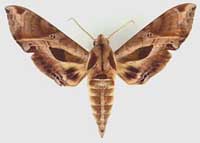 |
Eumorpha intermedia
WO, the Intermediate Sphinx
The Intermediate Sphinx Moth, (Eumorpha intermedia), (Wing span: 3 9/16 - 3 7/8 inches (9 - 9.8 cm)), flies in lower
austral and subtropical lowlands in North Carolina, Florida,
Mississippi, Louisiana, and South Texas.
|
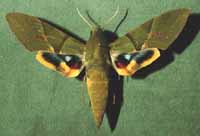 |
The Gaudy Sphinx flies in America, and although primarily a tropical
species, it has been taken as far north as Saskatchewan as a stray.
|
Eumorpha labruscae, December 29, 2007, Marc and Kurtis Cook
 |
If you have Grape or Virginia Creeper nearby, then you probably have
this species.
I often get asked to identify larvae from areas not
previously reported. |
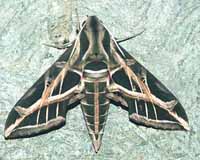 |
The upperside of the moth is dark pinkish brown. Each forewing has a
lighter brown band along the costa, and sharp pinkish white bands
and streaks. |
Macroglossini tribe:
 |
This day flier is widely distributed. If you have Virginia Creeper, you
probably have the Nessus Sphinx. Two bright, distinct, narrow yellow
bands are often visible on the abdomen.
|
 |
The lower wings of this hawkmoth are a solid brownish-orange,
matching the body colour.
You will often see this species listed as Darapsa pholus,
especially in older literature. |
 |
Darapsa myron
YA, the Virginia Creeper Sphinx or the
Grapevine Sphinx
If you have the
foodplants indicated in the common names, you probably have this
species nearby. The lower wings are orange. |
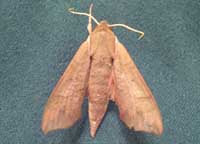 |
Darapsa myron pale form,
YA, the Virginia Creeper Sphinx or the
Grapevine Sphinx
If you have the
foodplants indicated in the common names, you might have this
species nearby. The lower wings are pinkish-orange.
I was quite surprised by the
pale colouration of this moth.
|
 |
If you have hydrangea growing near a stream, then you might have the
Hydrangea Sphinx.
|
 |
Hyles lineata
WO, the White-lined Sphinx
The forewing upperside is dark olive brown with paler brown along the
costa and outer margin, a narrow tan band running from the wing tip
to the base, and white streaks along the veins.
|
 |
This moth is very much under reported across the United States. It
is a rapid day flier so is probably not in too many collections.
Grape is a popular larval host.
|
 |
The upperside of the forewing is pale brown with lavender-gray at the base and
has dark brown lengthwise lines throughout.
This moth is a strong migrant.
|
Xylophanes tersa adult, January 2008, Plant City, Yolanda Acevedo.
Xylophanes tersa adult, July 2009, Brandon, Yolanda Acevedo.
|
|
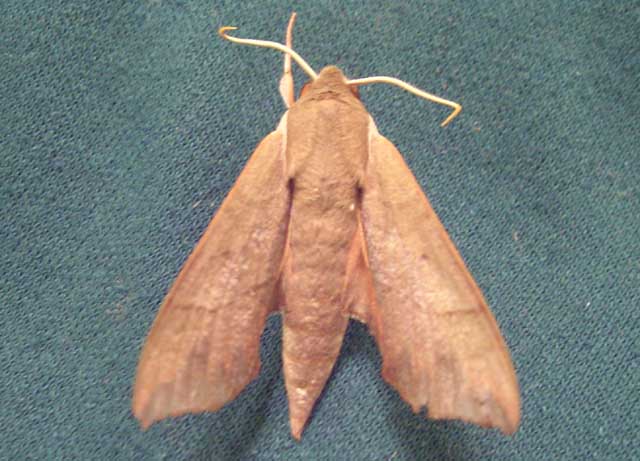
Darapsa myron (pale form), Hillsborough River State Park in Tampa,
Florida,
April 29, 2006,
courtesy of Yolanda Acevedo.
Yolanda writes, "I collected this specimen at Hillsborough River
State Park in Tampa, FL on April 29, 2006. I'm afraid camping tents
don't make a good home for them in the Florida heat. This one was
overcome by heat (or maybe one of our Pathfinders?) It measures
1 1/4 inches long (3.2 cm). The bottom wings have a pinkish tint to
them."
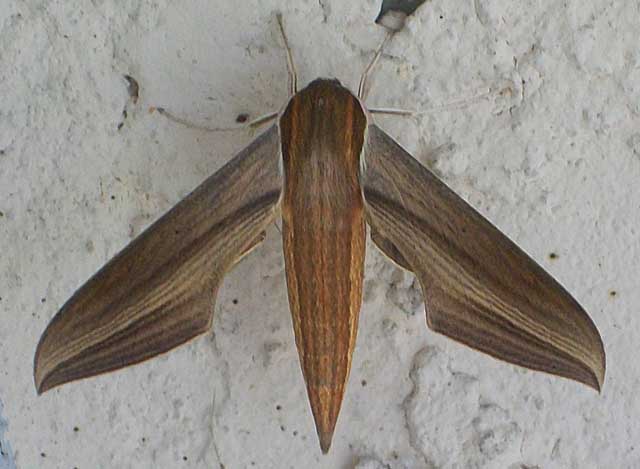
Xylophanes tersa, Brandon, July, 2009, courtesy of Yolanda Acevedo.
You can visit checklists for other states and countries in North, Central and South America via the links at
Sphingidae of the Americas.
This website has been created and is maintained by Bill Oehlke without government or institutional financial assistance. All expenses, ie., text reference
support material, webspace rental from Bizland, computer repairs/replacements, backups systems, software for image adjustments (Adobe Photoshop; L-View),
ftp software, anti-virus protection, scanner, etc. are my own.
I very much appreciate all the many images that have been sent to me, or of which I have been granted permission to copy and post from other websites.
All images on this site remain the property of respective photographers.
If you would like to contribute to the maintenance of this website by sending a contribution to
Bill Oehlke
Box 476
155 Peardon Road
Montague, Prince Edward Island, C0A1R0
Canada
your donation would be much appreciated and would be used for
1) paying for webspace rental;
2) paying for computer maintenance and software upgrades;
3) purchases of additional text reference material (journals and books) in anticipation of expanding the site to a worldwide Sphingidae site;
4) helping to pay my daughter's tuition; with anything left over going to humanitarian aid.
If you are mailing a check from USA, please use $0.85 postage. Donations can also be made through Paypal via the button below.
Enjoy some of nature's wonderments, giant silk moth cocoons.
These cocoons are for sale winter and fall. Beautiful Saturniidae moths will emerge the following spring and summer.
Read Actias luna rearing article.
Additional online help available. Eggs of many North American species are offered during the spring and summer. Occasionally
summer Actias luna and summer Antheraea polyphemus cocoons are available. Shipping to US destinations is done
from with in the US.
Use your browser "Back" button to return to the previous page.
This page is brought to you by
Bill Oehlke and the
WLSS. Pages are on space rented from Bizland. If you would like
to become a "Patron of the Sphingidae Site", contact Bill.
Please send sightings/images to Bill. I will do my best to respond to
requests for identification help.
 | 
Show appreciation for this site by clicking on flashing butterfly to the left.
The link will take you to a page with links to many insect sites. |








